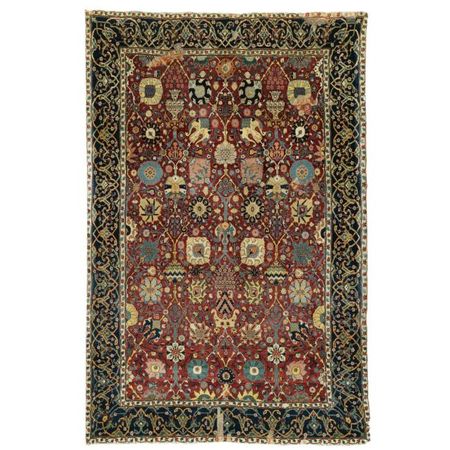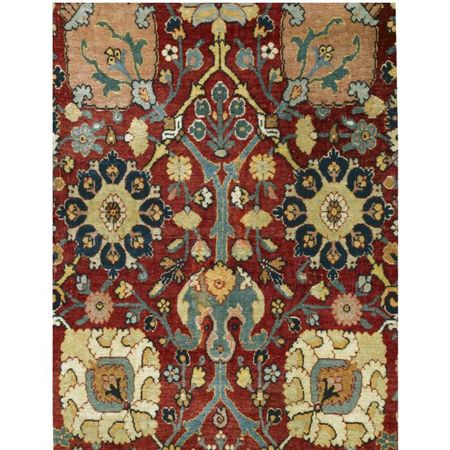The "Jeziorak" 'vase' carpet, possibly Kirman, Southeast Persia, 17th century
The "Jeziorak" 'vase' carpet, possibly Kirman, Southeast Persia, 17th century
approximately 270 by 175cm. Estiimate 600,000—800,000 USD
TECHNICAL ANALYSIS: Warp: cotton, ivory, Z4S
Weft: 1st and 3rd shoots wool, brown, grey, blue, light red,
green, Z2S, 2nd shoot: silk, ivory, 2Z
Pile: wool, 2Z, rarely 3Z, asymmetrical knot, open to the left
Density: 6 horizontal, 6 vertical per linear cm.
Sides: not complete
Ends: not complete
Colours: ivory, tan, light brown, pink, deep red, orange, yellow, orange-yellow, light olive, light green, mid-green, mid-blue-green, light turquoise, sky blue, blue, mid-blue
PROVENANCE : Poland, church of Jeziorak, by repute
Dr Albert Figdor, Vienna, acquired before 1908
Dr. Heinrich Thyssen-Bornemisza
Carmen Thyssen-Bornemisza Collection
EXHIBITED: Sammlung Schloss Rohoncz, Munich, Neue Pinakothek, 1930
International Exhibition of Persian Art, London, Royal Academy of Arts, 7 January – 28 February 1931
Donald King and David Sylvester, The Eastern Carpet in The Western World from the 15th to the 17th Century, (exh. cat.), Arts Council of Great Britain and the Hayward Gallery, London, 1983, no. 79, p. 100
LITERATURE AND REFERENCES: F. Sarre, Altorientalische Teppiche, Leipzig, 1908, pl.10
O. van Falke, Die Sammlung Dr Albert Figdor, Vienna and Berlin, 1930, vol. I, pl. L, no. 203
A. Feulner, Stiftung Sammlung Schloss Rohoncz, Teil 3. Plastik und Kunsthandwerk, Lugano-Castagnola, 1941, pl. 86, no. 648
R.L. Heinemann, Sammlung Schloss Rohoncz, Lugano-Castagnola, 1958, K 648
May H. Beattie, The Thyssen-Bornemisza Collection of Oriental Rugs, Lugano-Castagnola, 1972, pl. 1
E. Gans-Ruedin, Splendeur du tapis persan, Friborg, Switzerland, 1978, p. 131
Donald King and David Sylvester, The Eastern Carpet in The Western World from the 15th to the 17th Century, (exh. cat.), Arts Council of Great Britain and the Hayward Gallery, London, 1983, no. 79, p. 100
Toby Falk, ed., Treasures of Islam, Geneva: Museé Rath, London, 1985, p. 329, no. 340
Hali 65, 1992, p. 111
Jutan. Woven Flowers of the Silk Road, Osaka, National Museum of Ethnology, 1994, p. 77, fig. 56
Friedrich Spuhler, The Thyssen-Bornemisza Collection: Carpets and Textiles, London, 1998, pp. 116-119, pl. 27
NOTE: This remarkable "vase" technique carpet was reputedly found in the Jeziorak church in Poland. When first published by Friedrich Sarre in 1908, it was in the possession of Dr. Albert Figdor of Vienna who was also a previous owner of the Safavid silk and metal-thread kilim once in the collection of the Baron Thyssen-Bornemisza. Dr. Figdor (1843-1927) was one of the most important private collectors of the Austro-Hungarian Empire and amassed a highly significant and comprehensive collection of mostly decorative art objects dating from the Middle Ages to the nineteenth century. His genuine passion for collecting unique objects drove him to assemble an outstanding anthology of works that reflected his profound knowledge of the arts and his impeccable taste. Dr. Figdor started the collection in 1869 and constantly worked on enlarging it until his death in 1927. In 1891, he intended to donate part of his collection to the newly-founded Kunsthistorisches Museum in Vienna but no agreement was reached and the bequest was never carried out. The collection remained intact until 1930 when, three years after Dr. Figdor's death, many of the pieces were offered at auction in Vienna and Berlin. Since the lot offered here was first mentioned by Sarre in his 1908 book entitled Altorientalische Teppiche as the Figdor "vase" carpet, the piece must have become part of his collection prior to that date. It was after the doctor's death that this carpet entered the Thyssen-Bornemisza Collection thanks to the patronage of Heinrich Thyssen-Bornemissza (1875-1947), head of the German-Hungarian Thyssen-Bornemisza de Kászon et Impérfalva family whose noble lineage dated back hundreds of years. During his lifetime, the Baron amassed hundreds of artworks into one of the most important collections of the twentieth century. Along with the Jeziorak carpet, Heinrich Thyssen-Bornemisza was responsible for some of the most iconic weavings in the world entering the family's collection, including the Béhague-Sanguszko carpet. Europe's illustrious rug collectors, such as Wilhelm von Bode and Kurt Erdmann, sold their best pieces to the Baron, who quickly obtained some of the most important Safavid weavings known and attainable at the time. Interestingly, the Jeziorak carpet, similarly to most of the other now world-famous carpets in the Thyssen-Bornemisza collection, was used in the family's private home and was not exhibited in the Villa Favorita in Lugano. This suggests that these pieces, and carpets in general, were particularly dear to the Baron. When Heinrich Thyssen-Bornemisza died, the large collection was divided up among his heirs. Eventually, the new head of the family, Hans-Heinrich Thyssen-Bornemisza (1921-2002), bought back works from his relatives and put the collection together again. Hans-Heinrich Thyssen-Bornemisza continued in his father's path and enriched the family collection with exquisite rugs, carpets and textiles, and by the late twentieth century the Thyssen-Bornemisza Collection became one of the world's most important depositories of classical Persian carpets. The lot offered here is a true highlight of the collection and it exemplifies both the excellence of Safavid weavers but also the fineness of the Thyssen-Bornemisza Collection.
The term 'Vase' was first coined to refer to a group of carpets with designs featuring stylized vases which were all woven using a very specific method. The term has since been used to signify all of those carpets woven in this manner, whether their designs include vases or not, a group of carpets known as 'vase'-technique carpets. The structure of the 'vase'-technique group is very unusual having three passes of wefts after each row of knots and having multi-colored wefts placed in a seemingly haphazard fashion as if to use up oddments of wool. The use of fine silk for the second of the three wefts, as in the present example, denotes a carpet of the highest quality within the group. This fine weft creates extremely dense pile. The Jeziorak carpet displays both the structure and the design of a 'vase' carpet with a sophisticated lattice arrangement of ornate palmettes and vases. The carpet is unusual for its diminutive size. The geometric interiors of the vases and the lyrical arabesque border would suggest a mid-seventeenth century attribution.
Sotheby's. Arts of the Islamic World. 19 Mar 09. Doha www.sothebys.com photo courtesy Sotheby's

/https%3A%2F%2Fprofilepics.canalblog.com%2Fprofilepics%2F1%2F0%2F100183.jpg)




/http%3A%2F%2Fstorage.canalblog.com%2F34%2F01%2F577050%2F66379918_o.jpg)
/http%3A%2F%2Fstorage.canalblog.com%2F04%2F00%2F119589%2F66268897_p.jpg)
/http%3A%2F%2Fstorage.canalblog.com%2F05%2F37%2F119589%2F66268549_p.jpg)
/http%3A%2F%2Fstorage.canalblog.com%2F86%2F30%2F119589%2F66187962_p.jpg)